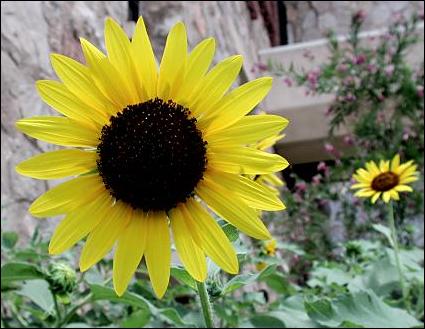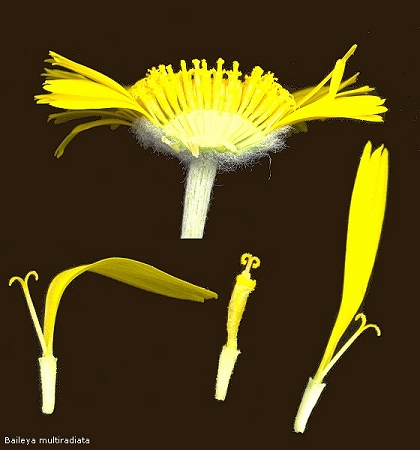

When's a flower not a flower? Actually, there are several answers, but one of them is when it's really a whole bunch of flowers. When it comes to members of the sunflower family, such as daisys, what we generally think of as the flower is really much more complicated—it's a whole collection of flowers mimicking one great, big flower.
Each of the so-called petals around the edge is a flower in itself, as
is each of the little units forming the central disk. The "petals" are called
ray flowers, and the little blossoms forming the center are disk flowers. Depending on
their position on the flower head, each of these little flowers, or florets, may have
both male and female parts, represent just one sex, or merely be sterile. Florets with
female parts each form a single seed. Some are like the familiar sunflower seeds, while
other plants have specialized parts to spread them around, such as the fluff attached
to the dandelion seed, allowing it to waft away on a gentle breeze.

Listen to the Audio (mp3 format) as recorded by KTEP, Public Radio for the Southwest.
Contributor: Arthur H. Harris, Laboratory for Environmental Biology, University of Texas at El Paso.
Desert Diary is a joint production of the Centennial Museum and KTEP National Public Radio at the University of Texas at El Paso.

Flower head of a sunflower. The yellow, strap-like "petals" (ligules) are the visible parts of the ray flowers, while the small dark brown florets they surround are disk flowers. Photograph by A. H. Harris.

The parts of a Desert Marigold flower head. At top, the head has been cut to show a vertical section. Below, two ray flowers flank a disk flower. Image by A. H. Harris.
You may find the sunflower family under two different, but equivalent, names: Compositae and Asteraceae.
Dimmitt, M. A. 2000. Asteraceae or Compositae (sunflower family). Pp. 170-177, in A natural history of the Sonoran Desert (S. J. Phillips and P. W. Comus, eds.). Arizona-Sonora Desert Museum Press, Tucson, 628 pp.
World of the Daisy. A Tasmanian site with a good, basic description of composites and a selection of Tasmanian examples.